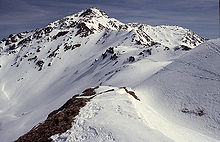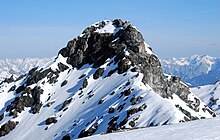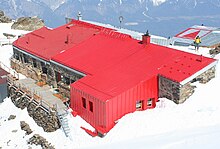Tux Alps
| Tux Alps | |
|---|---|
 Patscherkofel (2,246m/7,369ft) | |
| Highest point | |
| Peak | Lizumer Reckner |
| Elevation | 2,886 m (9,469 ft) |
| Coordinates | 47°10′N11°38′E/ 47.167°N 11.633°E |
| Geography | |
 | |
| Country | Austria |
| State | Tyrol |
| Parent range | Central Eastern Alps |
TheTux Alps(German:Tuxer Alpen) orTux Prealps(Tuxer Voralpen) are a sub-group of theAustrian Central Alps,which in turn form part of theEastern Alpswithin Central Europe. They are located entirely within the Austrian federal state ofTyrol.The Tux Alps are one of three mountain ranges that form an Alpine backdrop to the city ofInnsbruck.Their highest peak is theLizumer Reckner,2,886m (AA),which rises between the glen ofWattentaler Lizumand the valley of theNavisbach.Their name is derived from the village ofTuxwhich is tucked away in a side valley of theZillertal.
TheAlpine Club classification of the Eastern Alps (AVE)calls this range the Tux Alps. The name Tux Prealps was declared in the 1984 edition of the AVE as outdated and not longer applicable. The reality is that the mountain range can hardly be described as "prealps" in view of their sheer extent and height. The description only makes any sense when the range is seen in the context of theZillertal Alpsto the south, which are considerably higher than the Tux Alps and permanently covered in glaciers.
Neighbouring ranges
[edit]The Tux Alps are surrounded by the following other ranges in the Alps:
- Karwendel(to the north)
- Brandenberg Alps(to the northeast)
- Kitzbühel Alps(to the east)
- Zillertal Alps(to the south)
- Stubai Alps(to the west)

Boundary
[edit]To the north thelower Inn valleyforms the boundary of this range from Innsbruck downstream to the Inn's confluence with the Ziller.The Ziller valley (Zillertal) borders the range in the east from the mouth of the Ziller on the Inn upstream as far asMayrhofen.In the south theTuxertalvalley outlines the range from Mayrhofen to Hintertux. From there the boundary continues up to the saddle of theTuxer Jochand through theSchmirntalvalley toSankt Jodok.To the west the Tux Alps are bounded by theWipptalvalley from Sankt Jodok downstream to Innsbruck.
TheTuxer Jochsaddle links the Tux Alps to the Zillertal Alps.
The Tux Alps are a popularski touringand hiking area. Its ski resorts are Glungezer, Lizum im Wattental,Hochfügen-Hochzillertal,Penken and Kellerjoch, Patscherkofel. ThePatscherkofelmountain was a venue for the1964and1976 Winter Olympicsheld in nearbyInnsbruck.
Major peaks
[edit]- Lizumer Reckner,2,886 m
- Geier,2,857 m
- Kalkwand,2,826 m
- Rosenjoch,2,796 m
- Rastkogel,2,762 m
- Malgrübler,2,749 m
- Hirzer,2,725 m
- Glungezer,2,677 m
- Gilfert,2,506 m
- Grüblspitze,2,395 m
- Kellerjoch,2,344 m
- Patscherkofel,2,246 m
Geology
[edit]
The largest part of the Tux Alps compriseslow grade metamorphicrocks, that are classified as part of theInnsbruck quartz-phyllite complex(quartziticphylliteslate). Next to this zone ofPaleozoicrocks to the south there is a localised zone of variousMesozoicrocks, the so-calledTarntal Mesozoic.This complex zone belongs, like the quartz-phyllite zone, to the tectonic unit of the Lower Eastern Alps. Amongst the rocks of Tarntal Mesozoic may be founddolomiteandlimestonesthat are the basis of rock faces (KalkwandandTorwand) in the area of the Wattentaler Lizum. On the other hand, there are also elements of the former ocean bed, in the shape ofserpentinitethat make up the Lizumer Reckner. The southern perimeter of the Tux Alps belongs to the tectonically deeper-lyingPenninicHohe Tauern window.[1]Here in the Tux Alps these are mainly rocks of the PenninicGlockner Nappe(calc-schist envelope of the Tauern). The northeasternmost corner of the Tux Alps, from the area ofSchwaztoFügen im Zillertal,belongs to the Upper Eastern Alpinegreywacke zone,which consists of Paleozoic rocks.Silverandcopperwere once extensively mined in this zone in the area around Schwaz.[2]
Long-distance hiking trails
[edit]The long-distance hiking trail known as the "Munich to Venice Dream Path" (Traumpfad München-Venedig) runs through the Tux Alps. This is not an officiallong-distance trail.Nevertheless, the route, which was first proposed in 1977, has achieved a greater profile than many of the other trails officially established and maintained by states or rambling clubs.
The 9th day leg of the dream trail runs from Hall in Tirol up to theGlungezer Hut;the next stage over theseven tuxer summitsand the Naviser Jöchl to theLizumer Hutwhich is operated by the Austrian Alpine Club section at Hall.
The 10th and 11th days run from the Lizumer Hut to theTuxer Joch Haus,then over the Pluderling Saddle and the Gschützspitze Saddle.
Other long-distance trails in the Tux Alps are the Eagle Way (Adlerweg), theVia Alpina(red), Olympic Way (Olympiaweg), Glungezer & Geier Way No. 335 (Glungezer&Geier-Weg 335), and Central Alpine Way No. 02a.
Huts
[edit]
The following Alpine Club huts are located in the Tux Alps:
- Glungezer Hut
- Kellerjoch Hut
- Lizumer Hut
- Meißner Haus
- Navis Hut
- Patscherkofelhaus
- Rastkogel Hut
- Vinzenz Tolling Hut
- Voldertal Hut
- Weertal Hut
- Weiden Hut

